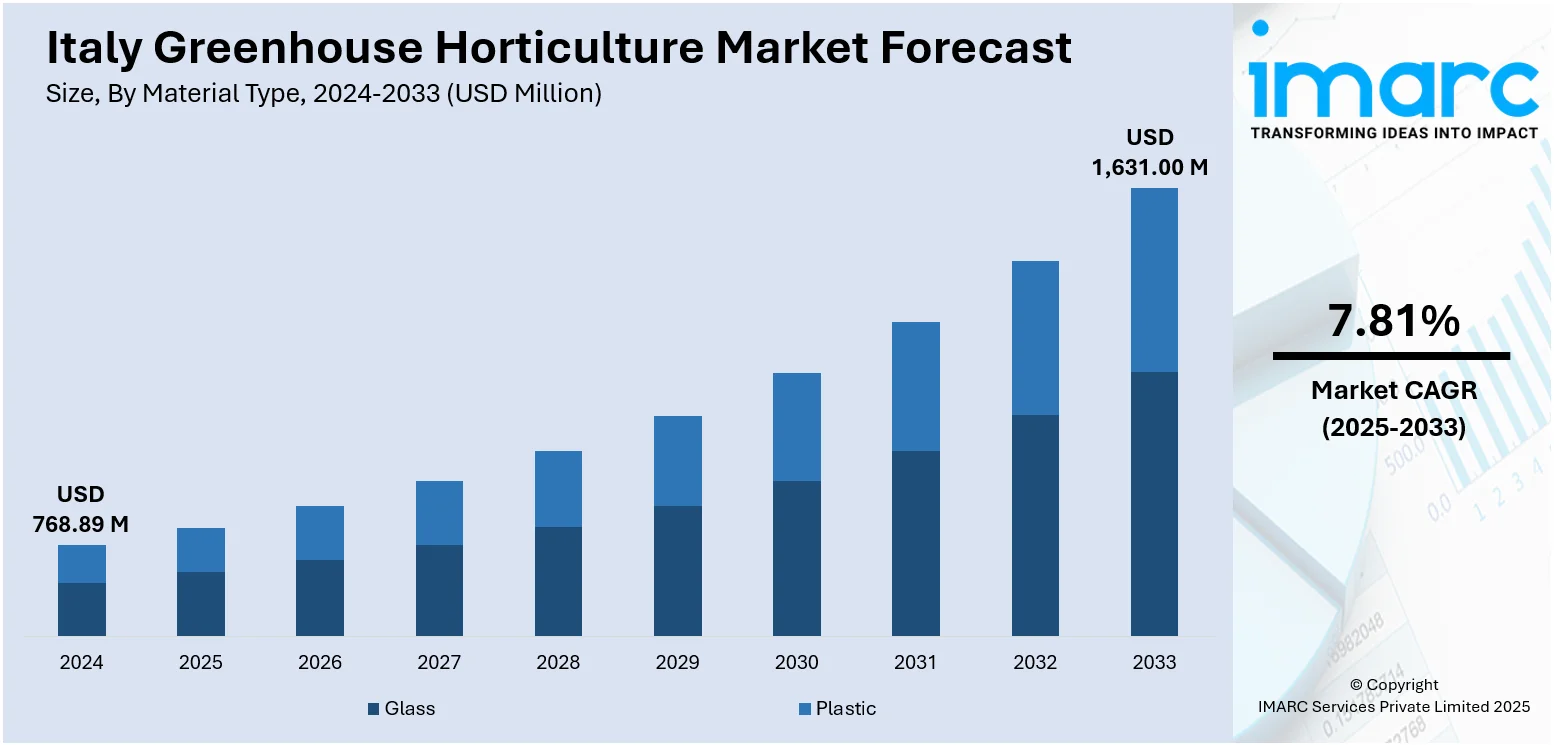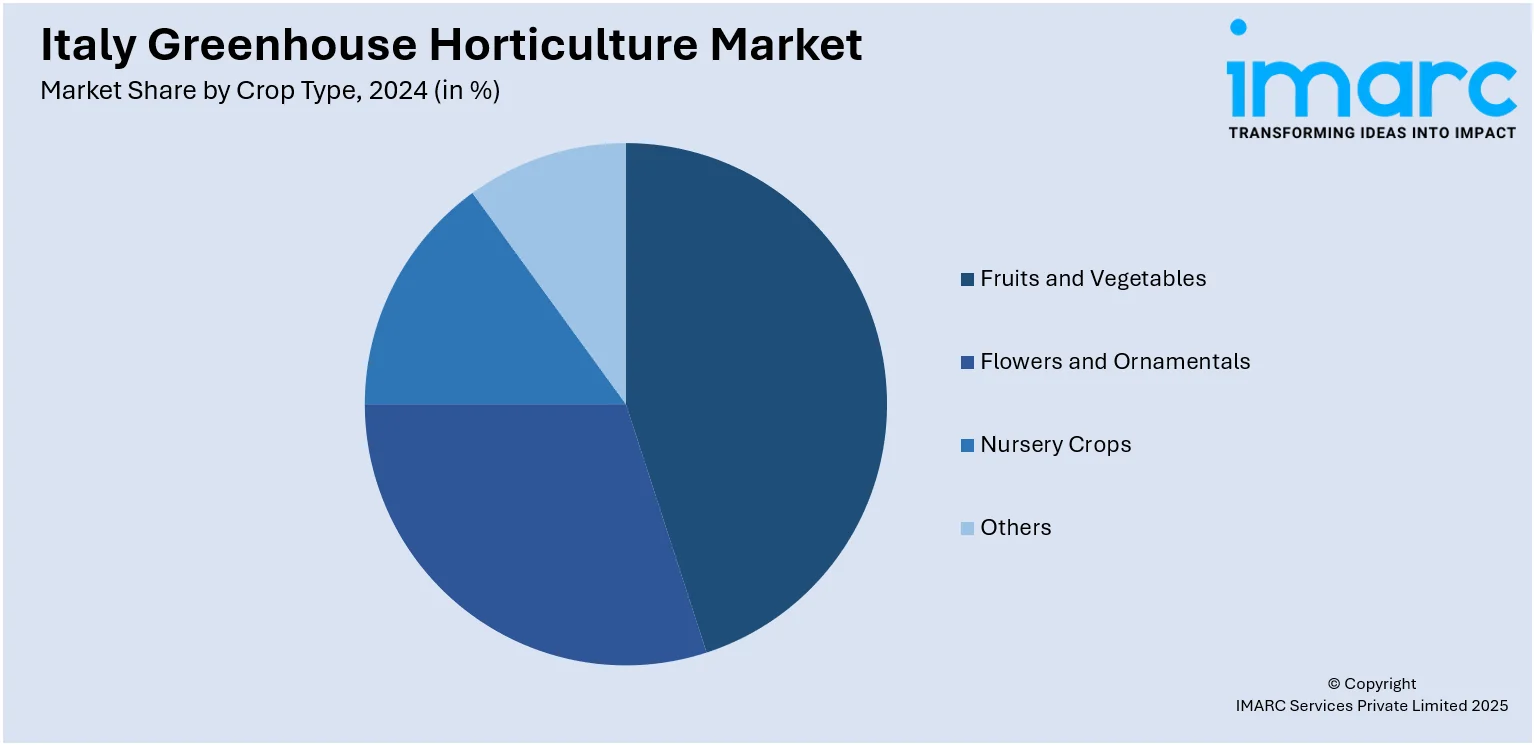
Italy Greenhouse Horticulture Market Size, Share, Trends and Forecast by Material Type, Crop Type, Technology, and Region, 2025-2033
Italy Greenhouse Horticulture Market Overview:
The Italy greenhouse horticulture market size reached USD 768.89 Million in 2024. The market is projected to reach USD 1,631.00 Million by 2033, exhibiting a growth rate (CAGR) of 7.81% during 2025-2033. The market is fueled by the rising demand for fresh, high-quality locally grown fruits, vegetables, and ornamental plants due to the rising consumer demand for fresh and sustainable produce. Besides that, technology improvements in controlled-environment agriculture equipment are boosting productivity and efficiency of resources. Additionally, incentives from the government in terms of adopting sustainable agriculture methods and using renewable sources of energy in horticulture are augmenting the Italy greenhouse horticulture market share.
|
Report Attribute
|
Key Statistics
|
|---|---|
|
Base Year
|
2024
|
|
Forecast Years
|
2025-2033
|
|
Historical Years
|
2019-2024
|
| Market Size in 2024 | USD 768.89 Million |
| Market Forecast in 2033 | USD 1,631.00 Million |
| Market Growth Rate 2025-2033 | 7.81% |
Italy Greenhouse Horticulture Market Trends:
Adoption of Emerging Greenhouse Technologies
The industry is witnessing a major transition towards the adoption of emerging technologies to maximize productivity and resource utilization. Automated climate management systems, precision irrigation, and sensor-based monitoring are being increasingly adopted to ensure optimal growing conditions, minimize labor expenses, and enhance crop production. Hydroponic and aquaponic systems are widely adopted as they allow year-round production with lower water and land use. LED grow lighting is also gaining traction due to its energy efficiency and can boost plant growth cycles. Moreover, artificial intelligence and data analytics are being used to track crop health, forecast yields, and identify early signs of pest infestation. In addition to enhancing working efficiency, these technologies also help promote sustainable modes of production in accordance with Italy's efforts to mitigate its environmental footprint. Moreover, the extensive use of these solutions is revolutionizing conventional greenhouse farming as highly productive, modern-day technologically equipped operations, and allowing producers to satisfy increasing consumer demand for fresh, high-quality, and sustainably produced produce.

To get more information on this market, Request Sample
Shift Toward Sustainable and Eco-Friendly Practices
Sustainability has emerged as a central trend supporting the Italy greenhouse horticulture market growth, driven by regulatory policies, consumer preferences, and environmental concerns. Greenhouse operators are increasingly investing in energy-efficient structures, renewable energy sources such as solar panels and biomass heating, and rainwater harvesting systems to minimize resource consumption. According to industry reports, Italy represents 4.1% of the world's total greenhouse cultivation area. In addition, the adoption of biological pest control and organic farming techniques is growing, reducing reliance on chemical pesticides and fertilizers while meeting the rising demand for eco-certified produce. Many producers are also incorporating closed-loop nutrient recycling systems, which optimize fertilizer use and reduce environmental runoff. Additionally, sustainable packaging solutions are being introduced to align with the broader green supply chain initiatives in the agri-food sector. This shift is further supported by European Union incentives promoting low-carbon agriculture and Italy's national sustainability goals. Apart from this, the movement toward eco-friendly practices not only strengthens the market's environmental credentials but also enhances the competitiveness of Italian greenhouse products in both domestic and export markets.
Expansion of High-Value Crop Cultivation
The market is witnessing an increased focus on the production of high-value crops, driven by growing domestic and international demand for premium-quality produce. Crops such as specialty tomatoes, strawberries, exotic herbs, and ornamental plants are being cultivated under controlled environments to ensure consistent quality, taste, and appearance. As per industry reports, from 2016 to 2024, the covered cultivation area for tomatoes expanded from 7,160 to 8,680 hectares, while lettuce increased from 4,550 to 5,530 hectares. Greenhouse systems allow for year-round production, enabling suppliers to meet off-season demand and secure higher market prices. Producers are also diversifying into niche crops, including medicinal plants and gourmet vegetables, which cater to health-conscious and gourmet food markets. This expansion is supported by advancements in varietal development, allowing for improved disease resistance, longer shelf life, and better adaptability to greenhouse conditions. Export-oriented growers are leveraging Italy's strong agricultural reputation to target high-value markets in Europe and beyond. The emphasis on premium, differentiated produce not only boosts profitability for growers but also aligns with evolving consumer preferences for unique, traceable, and high-quality food products.
Italy Greenhouse Horticulture Market Segmentation:
IMARC Group provides an analysis of the key trends in each segment of the market, along with forecasts at the country and regional levels for 2025-2033. Our report has categorized the market based on material type, crop type, and technology.
Material Type Insights:
- Glass
- Plastic
The report has provided a detailed breakup and analysis of the market based on the material type. This includes glass and plastic.
Crop Type Insights:

- Fruits and Vegetables
- Flowers and Ornamentals
- Nursery Crops
- Others
A detailed breakup and analysis of the market based on the crop type have also been provided in the report. This includes fruits and vegetables, flowers and ornamentals, nursery crops, and others.
Technology Insights:
- Heating System
- Cooling System
- Others
A detailed breakup and analysis of the market based on the technology have also been provided in the report. This includes heating system, cooling system, and others.
Regional Insights:
- Northwest
- Northeast
- Central
- South
- Others
The report has also provided a comprehensive analysis of all the major regional markets, which include Northwest, Northeast, Central, South, and others.
Competitive Landscape:
The market research report has also provided a comprehensive analysis of the competitive landscape. Competitive analysis such as market structure, key player positioning, top winning strategies, competitive dashboard, and company evaluation quadrant has been covered in the report. Also, detailed profiles of all major companies have been provided.
Italy Greenhouse Horticulture Market News:
- May 2025: Industry leaders from Italy and the UK announced the official launch of GreenItaly, the newly AIPH-approved international horticultural trade exhibition scheduled for October 2025 in Parma, designed to highlight Italy’s strengths across the ornamental supply chain. The launch event focused on how climate change is reshaping horticultural production, plant selection, and landscape design, and called for adaptive, collaborative responses among professionals. Experts emphasized viewing landscape as infrastructure and plants as ecological actors, stressing the need for climate-adapted species, resilient planting strategies, and cross-sectoral design innovation.
- December 2024: Italian greenhouse supplier Lucchini unveiled BoxXLand, a pioneering greenhouse solution built within shipping containers and outfitted with DGT by Senmatic’s integrated LED grow lights, fertilizer mixers, and climate-control systems. This robust, plug-and-play configuration enables precise, controlled cultivation of delicate crops—such as lettuce and herbs—even in harsh or remote environments. An early trial at HAMK University in Finland demonstrated promising growth of iceberg lettuce under this modular system, highlighting its potential for decentralized, “0 km” production in areas traditionally dependent on imported produce.
Italy Greenhouse Horticulture Market Report Coverage:
| Report Features | Details |
|---|---|
| Base Year of the Analysis | 2024 |
| Historical Period | 2019-2024 |
| Forecast Period | 2025-2033 |
| Units | Million USD |
| Scope of the Report |
Exploration of Historical Trends and Market Outlook, Industry Catalysts and Challenges, Segment-Wise Historical and Predictive Market Assessment:
|
| Material Types Covered | Glass, Plastic |
| Crop Types Covered | Fruits and Vegetables, Flowers and Ornamentals, Nursery Crops, Others |
| Technologies Covered | Heating System, Cooling System, Others |
| Regions Covered | Northwest, Northeast, Central, South, Others |
| Customization Scope | 10% Free Customization |
| Post-Sale Analyst Support | 10-12 Weeks |
| Delivery Format | PDF and Excel through Email (We can also provide the editable version of the report in PPT/Word format on special request) |
Key Questions Answered in This Report:
- How has the Italy greenhouse horticulture market performed so far and how will it perform in the coming years?
- What is the breakup of the Italy greenhouse horticulture market on the basis of material type?
- What is the breakup of the Italy greenhouse horticulture market on the basis of crop type?
- What is the breakup of the Italy greenhouse horticulture market on the basis of technology?
- What is the breakup of the Italy greenhouse horticulture market on the basis of region?
- What are the various stages in the value chain of the Italy greenhouse horticulture market?
- What are the key driving factors and challenges in the Italy greenhouse horticulture market?
- What is the structure of the Italy greenhouse horticulture market and who are the key players?
- What is the degree of competition in the Italy greenhouse horticulture market?
Key Benefits for Stakeholders:
- IMARC’s industry report offers a comprehensive quantitative analysis of various market segments, historical and current market trends, market forecasts, and dynamics of the Italy greenhouse horticulture market from 2019-2033.
- The research report provides the latest information on the market drivers, challenges, and opportunities in the Italy greenhouse horticulture market.
- Porter's five forces analysis assist stakeholders in assessing the impact of new entrants, competitive rivalry, supplier power, buyer power, and the threat of substitution. It helps stakeholders to analyze the level of competition within the Italy greenhouse horticulture industry and its attractiveness.
- Competitive landscape allows stakeholders to understand their competitive environment and provides an insight into the current positions of key players in the market.
Need more help?
- Speak to our experienced analysts for insights on the current market scenarios.
- Include additional segments and countries to customize the report as per your requirement.
- Gain an unparalleled competitive advantage in your domain by understanding how to utilize the report and positively impacting your operations and revenue.
- For further assistance, please connect with our analysts.
 Request Customization
Request Customization
 Speak to an Analyst
Speak to an Analyst
 Request Brochure
Request Brochure
 Inquire Before Buying
Inquire Before Buying




.webp)




.webp)












